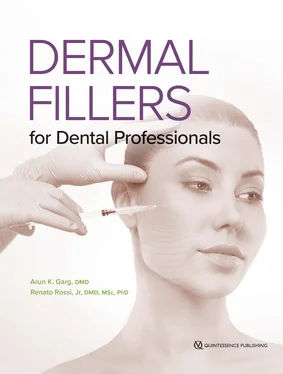The two materials in this category are collagen and hyaluronic acid, both of which are natural components of human tissue.
Collagen
Introduced in the 1970s, injectable fillers made of bovine collagen were the first products to be FDA cleared to smooth the appearance of lines and wrinkles associated with facial aging. Because of public anxiety about the safety of animal-derived products, they became obsolete when human-derived collagen fillers reached the market a few years later. The addition of lidocaine boosted the popularity of collagen fillers, and they would remain the gold standard for the next 20 years.
Human-derived collagen fillers are nonantigenic, safe, and fast-acting, and they require no downtime. The collagen resorbs quickly, however, limiting the duration of their effect to only 3 months. By the late 1990s, this rapid resorption rate sealed their fate, and collagen fillers went the way of other popular 1980s trends like big hair and shoulder pads. Collagen dermal fillers are no longer being manufactured, although even today it is not uncommon for some patients to ask for them by name.
During the same period, neurotoxins were being used to relax and soften the wrinkles caused by the contraction of facial muscles—with excellent results. This breakthrough led to recognition of the different etiologies of the lines formed by movements of expression and the grooves in the skin resulting from a loss of volume associated with aging. 11 The former can be temporarily paralyzed with botulinum toxin injections (which is a subject for another time), whereas age-related wrinkles can be smoothed only by restoring the lost volume. This recognition spurred development of new fillers made from a variety of materials.
Hyaluronic acid
Hyaluronic acid (HA) is the most popular class of filler in the United States, for several reasons 10,11(Fig 3-2). HA fillers are easy to handle and provide natural-looking results with little downtime. They also boast an important safety advantage over other types of fillers in that they can be immediately and safely reversed with hyaluronidase, making them especially favored by inexperienced clinicians.
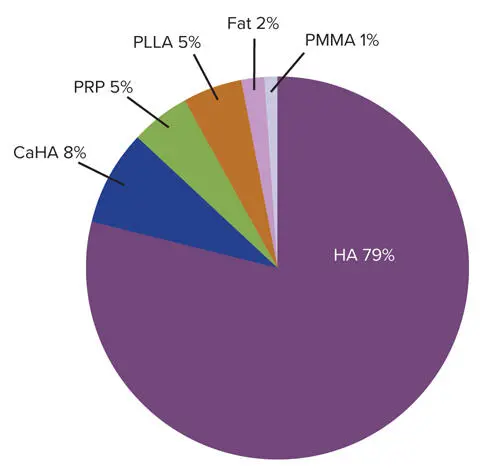
FIG 3-2Percentage of filler procedures performed in the United States in 2018 by agent used. The total number of procedures was 2,676,970. (Source: American Society of Plastic Surgeons. 10 ) CaHA, calcium hydroxyapatite; PRP, platelet-rich plasma; PLLA, poly-l-lactic acid; PMMA, polymethylmethacrylate.
HA was the first filler agent to achieve the definitive rejuvenation effects on static lines and grooves that botulinum toxins have on dynamic lines. Produced naturally by the body and found in high concentrations in the skin, HA binds collagen and water together to provide hydration and augmentation. Like collagen fillers, HA is naturally biocompatible, but it resorbs at a significantly slower rate. Because of its excellent moisture-retention capacity, HA is a key ingredient in many high-end skin care products on the market today.
The first commercially available HA fillers—of which there are many (Figs 3-3 to 3-7)—were FDA cleared in 2003, and in 2018 they accounted for 77% of all dermal filler sales in the United States. 10 Juvéderm (Allergan), which is available in several different formulations, is the undisputed market leader, followed by Restylane (Galderma) and Belotero Balance (Merz North America). HA filler products differ in terms of their rheologic and physicochemical properties (eg, degree of HA concentration, particle size, consistency, viscosity, hardness, degree of water solubility, cross-linking technology), which play an important role in HA filler selection, location and plane of injection, and clinical outcomes. In general, more concentrated products with a greater degree of cross-linking (a manufacturing process used to slow resorption rate) provide increased longevity, but they have on occasion been associated with a higher risk for inflammation and nodule formation ( Table 3-2). 12–14In addition, a higher G’ (elasticity) means a stiffer gel and a deeper injection plane, and conversely a lower G’ indicates a softer gel and a more superficial plane of injection. 3 Skin quality, degree of skin laxity, and anatomical location are some of the clinical factors that must be considered when selecting a product. Understanding the rheologic properties of the various HA products can make esthetic enhancement safer and more predictable.
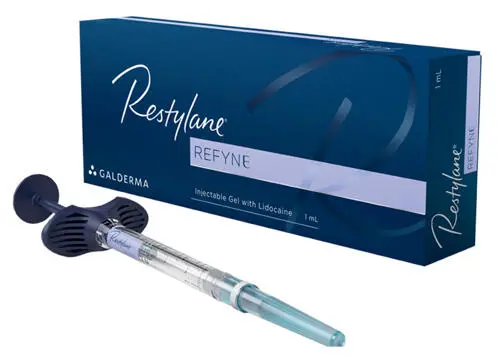
FIG 3-3Restylane was the first HA filler to be cleared by the FDA in 2003. In the time since, this manufacturer has launched several other formulations, and today Restylane is the second-best-selling filler in the United States. Restylane Refyne treats mild to moderate lines and wrinkles, while Restylane Defyne is for moderate to severe smile lines. Both fillers last up to 12 months. Restylane Silk was the first HA dermal filler to be approved for lip injection via cannula. It is a smoother, lighter injection that produces fuller and more accentuated lips. Restylane Lyft is a heavier, more concentrated mixture for the back of the hands and face that adds lift and volume to the cheeks.
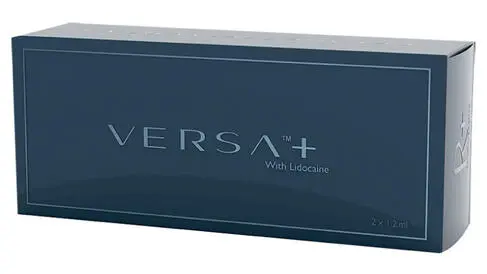
FIG 3-4Revanesse Versa (and Versa+) is engineered to minimize swelling and to maintain balance with the water content of the surrounding skin tissue. It is intended for the treatment of lines and folds in the lower face and for adding volume to the lips. Because it will neither increase nor decrease the water in the skin, Versa can help clinicians avoid over- or undertreatment in the area of injection.
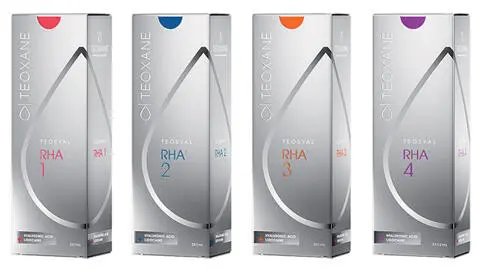
FIG 3-5The Teosyal RHA line of HA products includes the first resilient HA fillers dedicated to facial dynamics. RHA 2, 3, and 4 have malleability properties to avoid resistance to facial movement. RHA 2 is designed for filling dynamic moderate wrinkles such as nasolabial folds, malar deficiencies, and glabella wrinkles. RHA 3 is designed for filling deep wrinkles in areas such as the nasolabial folds and vertical lip lines. RHA 4 is designed to increase volume in extended areas such as the cheeks, upper cheeks, and contours of the face.
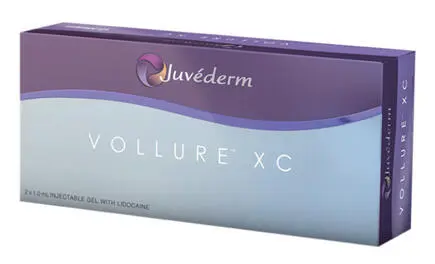
FIG 3-6Juvéderm offers a number of different formulations in its line of HA products, and the company outsells all other brands of dermal fillers in the United States. Vollure is best for treating wrinkles and fine lines in the lower third of the face (nasolabial folds and marionette lines), whereas Voluma is designed to correct age-related volume deficits in the midface (malar region and tear troughs) and chin areas. Volbella restores volume, contour, and symmetry to the lips and smooths perioral rhytids. Ultra XC and Ultra Plus XC both target moderate to severe facial wrinkles and folds in the midface, though Ultra Plus XC has a larger particle size and thus a longer duration of action (9 months vs 12 months). The Juvéderm family of products all contain lidocaine to reduce patient discomfort.
Читать дальше
